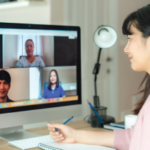Sheryl Mascarenhas, MD, on Going Virtual
The pandemic completely changed the way we teach medicine. One of the most dramatic changes came with the dissolution of in-person lectures and the pivot to video conferencing. Virtual education has numerous benefits. Learners no longer needed to cut clinics short to travel to a lecture hall, and with social distancing rules we did not have to worry about limiting the attendance for our lectures. Lecture times were no longer restricted to building hours.
However, as the use of virtual platforms ballooned during the pandemic, the limitations of virtual education also blossomed. It is easy for participants to lose focus and become unengaged in a virtual lecture. With numerous distractions, such as family, pets, laundry, cooking and catching up on clinical charting, zoning out while zooming in is all too easy.
In August 2020, the Ohio State University Rheumatology Fellowship Program launched the Innovative Fellow Education Series in an effort to improve learner engagement over virtual platforms. Rather than adding more lectures that could lead to further passive learning environments, the series focused on interactive educational activities that could be accomplished in a virtual setting.
The goals of the program were to allow fellows the opportunity to use their creative skills to develop an educational activity that corresponded to our monthly educational topic. Fellows would choose a mentor from the division to help design and run the activity.
The pilot program occurred during our inflammatory myopathy education month. Our chief fellow, Fahad Khan, MD, worked with me (i.e., the program director), to develop a myositis-specific antibody activity aimed at reviewing clinical presentations associated with various myositis-specific antibodies.
Patterned after the 1980s’ game show Classic Concentration, the activity included several picture puzzles in which the pictures demonstrated the key clinical features of a particular myositis presentation. For example, pictures representing amyopathy, rapidly progressive interstitial lung disease, fever, palmar papules and skin ulcerations were clues for anti-MDA-5 antibody.
During the activity, fellows divided into two breakout rooms and competed as teams against each other to identify the correct antibody. The activity allowed for a flipped classroom setting, where fellows on the team could teach each other as they worked through the puzzles. The feedback was highly positive. Fellows appreciated the high level of engagement and appeal to visual learners.
After the success of the pilot, each fellow was assigned a topic and developed their own educational activity over the year. These included Jeopardy-like games, case discussions, board-style review questions and practical applications of disease activity indices in rheumatoid arthritis.
The series’ primary goal of increasing engagement was actualized as it created a learning environment rooted in learner participation. It allowed for the development of fellow teaching skills and promoted mentoring within the division. The series also provided a much needed outlet for socialization during a pandemic year when so much of our activities for socialization were restricted.
We plan to continue the series into the coming year. This model can easily be replicated at other institutions and has potential for multiple
institutions to participate in the same—or similar—activities.


